Comms Panel - History Tab
Subject to user rights.
This is accessed by clicking the  button on the Toolbar and then the panel's
button on the Toolbar and then the panel's  History button.
History button.

Use this tab to see every communication that you have made and received (including missed calls).
Note: in some deployments, the tabbed Comms Panel is not available. Instead, history is provided in a standalone panel, accessible from the toolbar. If you prefer this setup, consult your local support desk.
|
|
Clicking this displays this Help page in a separate window. |
|
|
Hides the Comms panel. You can restore it by clicking the |
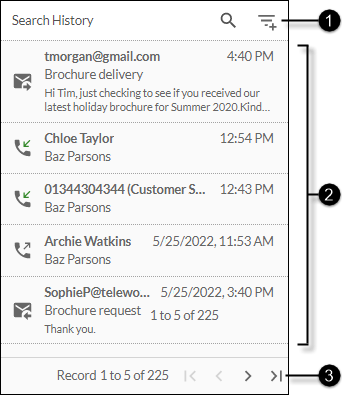
Note: clicking the  History button during your DTA session updates the tab to include the latest history items.
History button during your DTA session updates the tab to include the latest history items.
|
|
|
|
|
||||||||||||||||||||||||||||||||||||||||||||||||||||||||||||
|
|
|
Search History and Filters field |
Use this to search for a particular history record by whole word and then click the In the filtered list, clicking the Click the |
||||||||||||||||||||||||||||||||||||||||||||||||||||||||||||
|
|
|
Displays a summary of interaction history records in reverse chronological order (newest first).
Note: the date is not shown for today's calls. |
|||||||||||||||||||||||||||||||||||||||||||||||||||||||||||||
|
|
|
Pagination buttons |
Indicates the number of call history records that are currently in view and the total number of records in your call history. Use the arrow buttons to see records that not currently visible in the panel.
|
Call Details
Clicking a call item in the history displays the following details about the call directly below.
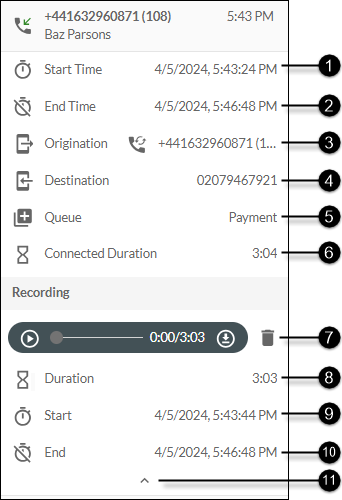
If an audio transcription for the call is available, a 'Show Transcript' button is displayed. When clicked, this shows the transcription in a Transcription panel.
Note: not all calls may be recorded.
|
|
|
|
|
|
|
|
Start Time |
The exact time at which the call was dialled. |
|
|
|
End Time |
The exact time at which the call ended. |
|
|
|
Origination |
The originating number of the call, or 'Withheld Number'. For an incoming call that arrived through a storm treatment such as a queue or a hunt group, the name of the treatment is displayed in brackets. Clicking the |
|
|
|
Destination |
The destination number of the call. |
|
|
|
Queue |
For an incoming call that arrived through a queue, this is the name of the queue. |
|
|
|
Connected Duration |
For a call that was connected, this is your talk time with the other party. This duration is always less than the difference between the call's start and end time because it does not include the duration between call initiation and call answer (such as the call setup time, the time spent by the caller in an IVR, queue wait durations). |
|
|
|
Recording Playback Controls |
Note: these are not shown for a recording whose playback time has expired. A set of controls for playing the call recording through your speakers. Click the The |
|
|
|
Duration |
The duration of the recording. |
|
|
|
Start |
The exact time at which the recording started. |
|
|
|
End |
The exact time at which the recording ended. |
|
|
|
Close Call Details sub-panel |
Click this to close the call details sub-panel. |
SMS Message Details
Clicking an incoming SMS message item in the history displays the following details about the message in a separate panel.
Incoming Message Details
Clicking an SMS message item in the history displays the following details about the message in a separate panel.
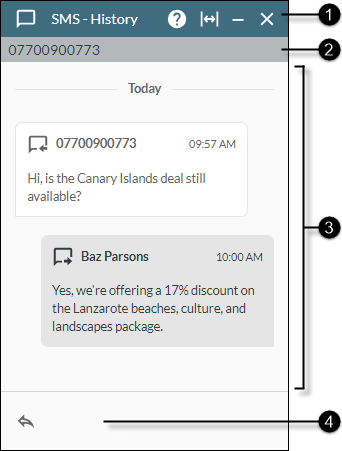
|
|
|
|
|
||||||||||
|
|
|
Panel Control buttons |
|
||||||||||
|
|
|
Sender |
The origination email address. |
||||||||||
|
|
|
Message |
The incoming SMS message and the reply if one was sent. |
||||||||||
|
|
|
Reply button |
Displays a SMS Reply sub-panel at the bottom of the panel for you to reply to the sender.
Shown below the editable field is the number of characters in the reply and the number of SMS messages that will be needed to send the reply.
|
Outgoing Message Details
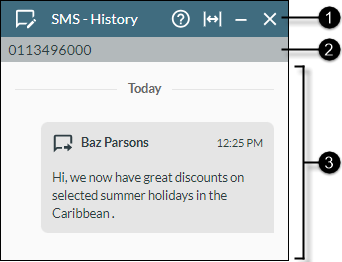
|
|
|
|
|
||||||||||
|
|
|
Panel Control buttons |
|
||||||||||
|
|
|
Originator |
The originating number (as configured by your administrator). |
||||||||||
|
|
|
Message |
The full outgoing SMS message |
Email Details
Clicking an incoming or outgoing email message item in the history displays the following details about the email in a separate panel.
Incoming Email Details
Clicking an email item in the history displays the following details about the email in a separate panel.
_EN.png)
|
|
|
|
|
||||||||||
|
|
|
Panel Control buttons |
|
||||||||||
|
|
|
Sender |
The origination email address. |
||||||||||
|
|
|
Subject |
The email subject. |
||||||||||
|
|
|
Latest message |
The most recent message in the email thread, which includes metadata and attachments. The date and time shown here is that at which the message was either received by storm or sent by you. |
||||||||||
|
|
|
Subthreads button |
Click this to see other messages in the email conversation. |
||||||||||
|
|
|
Original message |
The original incoming message, which includes metadata and attachments. The date and time shown here is that at which the message was received by storm. |
||||||||||
|
|
|
Notes |
Any notes that were added to the email. These are listed in reverse chronological order (newest first). |
||||||||||
|
|
|
Action buttons |
|
Outgoing Email Details
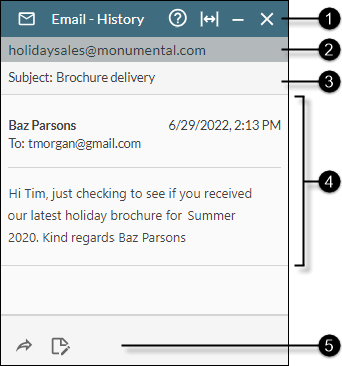
|
|
|
|
|
||||||||||
|
|
|
Panel Control buttons |
|
||||||||||
|
|
|
Presentation address |
The origination email address as seen by the recipient. |
||||||||||
|
|
|
Subject |
The email subject. |
||||||||||
|
|
|
Message |
The outgoing email message, which includes metadata and attachments. The date and time shown here is that at which the message was sent by you. |
||||||||||
|
|
|
Action buttons |
|
Social Media Details
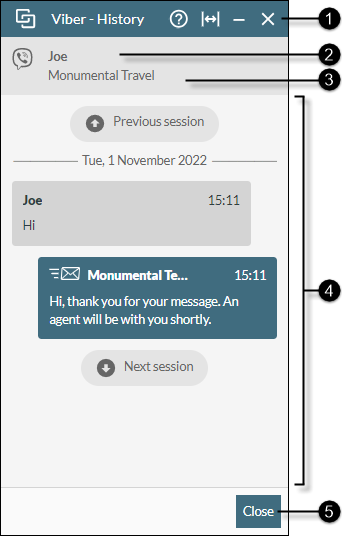
|
|
|
|
|
||||||||||
|
|
|
Panel Control buttons |
|
||||||||||
|
|
|
Sender |
The sender's social media account username. |
||||||||||
|
|
|
Destination |
The username of the destination social media account. |
||||||||||
|
|
|
Messages |
The messages in the interaction. |
||||||||||
|
|
|
Close button |
Closes the panel. |
Remarks
DTA allows you to play back recordings that were recorded in a third-party tool outside storm, such as in a CRM system, and which are not associated with calls made or received in DTA. Such recordings are displayed in a separate panel titled 'Call History' (not shown), instead of in the Comms panel. The Call History panel displays the same information and recording playback controls as seen in the Call Details section of the Comms panel.


 Comms button on the
Comms button on the 
 button (or press the keyboard Enter key) to filter the list to show items matching the search item.
button (or press the keyboard Enter key) to filter the list to show items matching the search item.  button clears the filter.
button clears the filter. button to filter your call history by time, origination, and destination. By default, the History panel displays calls made at any time ('Anytime'), to all destinations ('To Anyone'), and from all originations ('From Anyone').
button to filter your call history by time, origination, and destination. By default, the History panel displays calls made at any time ('Anytime'), to all destinations ('To Anyone'), and from all originations ('From Anyone').















 button for a non-withheld call initiates an outgoing call to the originating party.
button for a non-withheld call initiates an outgoing call to the originating party.



 button to download the recording to your PC Downloads folder as a WAV file.
button to download the recording to your PC Downloads folder as a WAV file. button is available if you are permitted to delete recordings. See also,
button is available if you are permitted to delete recordings. See also, 






 button in the
button in the 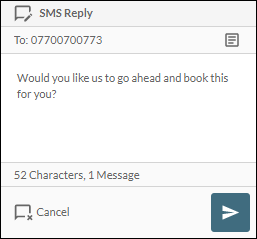


 Email button in the
Email button in the 
